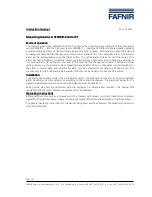
17
-. Codec
The codec settings are separated into MPEG4 and H.264.
H.264 is a
lso known as MPEG-4 Part 10. This is the new generation compression standard for
digital video. This function offers higher video resolution than Motion JPEG or MPEG-4 at the same
bit rate and bandwidth, or the same quality video at a lower bit rate.
-. Profile
There are 4 pre-programmed stream profiles available for quick set-up.
Choose the form of video encoding you wish to use from the drop-down list:
* H.264 MP(Main Profile):
Primarily for low-cost applications that requires additional error robustness, this profile
is used rarely in videoconferencing and mobile applications, it does add additional error
resilience tools to the Constrained Baseline Profile. The importance of this profile is
fading after the Constrained Baseline Profile has been defined.
* H.264 BP(Base Profile):
Originally intended as the mainstream consumer profile for broadcast and storage
applications, the importance of this profile faded when the High profile was developed
for those applications.
* MPEG4 SP(Simple Profile):
Mostly aimed for use in situations where low bit rate and low resolution are mandated
by other conditions of the applications, like network bandwidth, device size etc.
* MPEG4 ASP(Advanced Simple Profile):
Its notable technical features relative to the Simple Profile, which is roughly similar to
H.263, including "MPEG"-style quantization, interlaced video, B pictures (also known as
B Frames), Quarter Pixel motion compensation (Qpel), Global motion compensation
(GMC).
-. Resolution
It enables users to determine a basic screen size when having an access through the Web
Browser or PC program. The screen size control comes in seven modes like
4CIF(704x480), 2CIF(704x240), CIF(352x240), QCIF(176x120), VGA(640x480),
QVGA(320x240), and QQVGA(160x120). Users can reset the selected screen size anytime
while monitoring the screen on a real-time basis.
-. Bitrate control
Limiting the maximum bit rate helps control the bandwidth used by the H.264 or MPEG-4
video stream. Leaving the Maximum bit rate as unlimited maintains consistently good
image quality but increases bandwidth usage when there is more activity in the image.
Limiting the bit rate to a defined value prevents excessive bandwidth usage, but images
are lost when the limit is exceeded.
Note that the maximum bit rate can be used for both variable and constant bit rates.
The bitrate can be set as Variable Bit Rate (VBR) or Constant Bit Rate (CBR). VBR adjusts
the bit rate according to the image complexity, using up bandwidth for increased activity
in the image, and less for lower activity in the monitored area.
CBR allows you to set a fixed target bitrate that consumes a predictable amount of
bandwidth. As the bit rate would usually need to increase for increased image activity,
















































